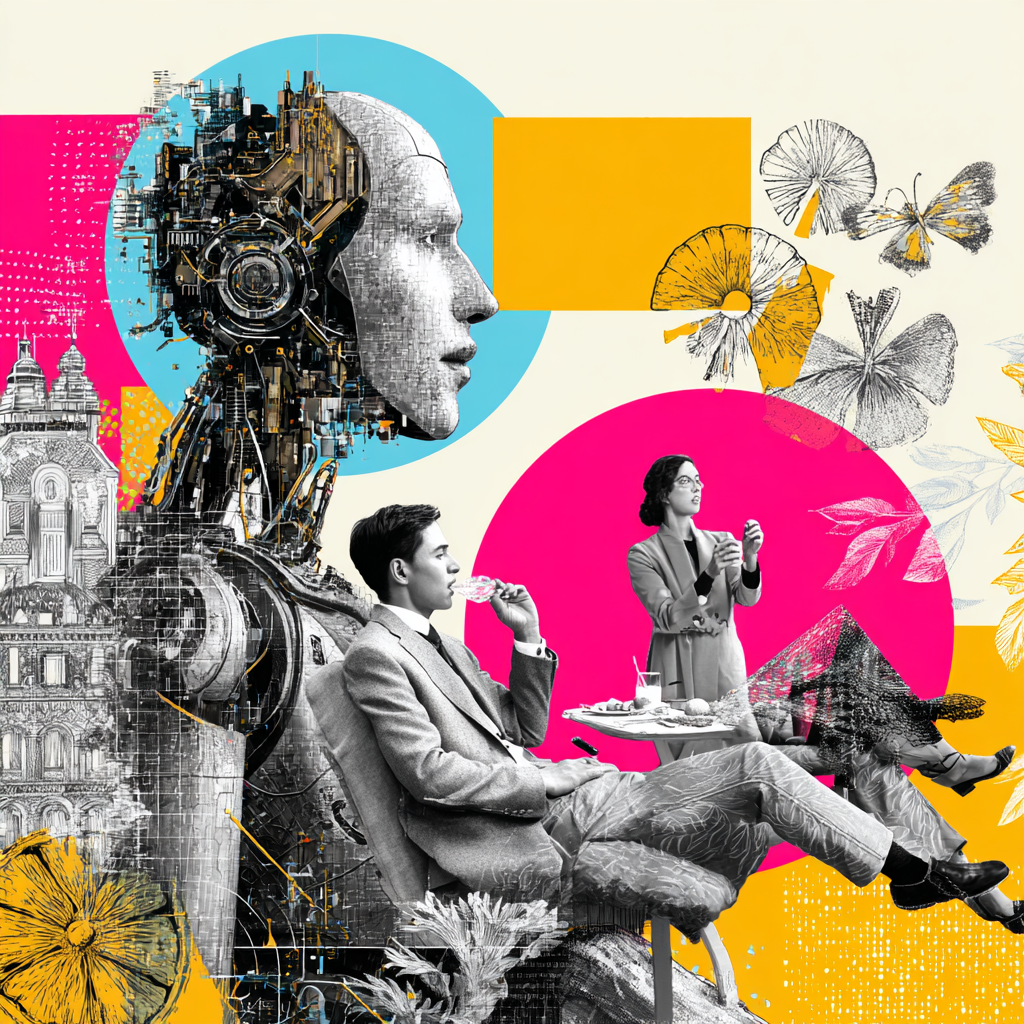
Estimated reading time: 14–16 minutes
Introduction: When Code Meets Chaos
If you’ve ever tried to teach a computer something “obvious”—like the difference between your dog and your neighbor’s dog—you already know the frustration. A classic program demands rules: If the ears are floppy, then… But halfway through you realize floppy-eared cats exist, ear-cropped dogs exist, and suddenly you’re drowning in exceptions.
Artificial intelligence (AI) arrived to rescue us from that rule-explosion. Instead of forcing you to write logic for every corner case, an AI model learns from examples and then generalizes to brand-new data. That simple shift—from hand-crafted rules to learned patterns—has started an industrial revolution of its own.
This post is a guided tour of that revolution. We’ll examine why “fuzzy” inputs are where AI shines, map out the moments in a workflow that benefit most from intelligence, and share practical stories from tinkerers and Fortune 500s alike. By the end you’ll have a mental checklist for deciding where to sprinkle AI magic and when a humble if statement still wins the day.
1 | Fuzzy Is the New Normal
What “fuzzy” really means
Data is fuzzy when it refuses to stay in neat boxes. A temperature reading of 72 °F is crystal-clear: numeric, bounded, unambiguous. But a selfie of your dog? Lighting, camera angle, background clutter—each photo is its own adventure. Human language is fuzzier still: “Sick track!” might praise a song or bemoan food poisoning.
Traditional software hates that ambiguity. It thrives on binary decisions and explicit thresholds. Once you feed it messy input, the poor thing panics—unless you spend months coding every possible edge case.
Why machines learn what rules can’t
Imagine trying to hard-code rules for every shade of sarcasm on Twitter. By the time you finish version 1.0, language has morphed again. Machine-learning models tackle the problem differently: give them millions of tweets with labels (sarcastic, not sarcastic). They discover statistical patterns—word order, emoji choice, punctuation flair—that point to what humans mean rather than what they literally say.
That knack for reading between the lines makes AI indispensable whenever data gets slippery: photos, sound, slang, or sensor readings from the physical world. The fuzzier the domain, the louder AI whispers, Use me here.
2 | Where Intelligence Belongs in a Workflow
Picture a coffee-bean-shaped pipeline: raw data pours in, gets refined step by step, and finally triggers a decision. The temptation is to bolt an AI model onto the last step—“Is this photo safe for work? Let the neural network decide.” But the biggest gains usually come upstream, where raw data first flows in.
A tale of two receipt scanners
A startup we’ll call QuickBooks-Next tried to automate expense reports. Attempt 1 relied on shipping every receipt photo straight to Optical Character Recognition (OCR) and then running brittle regex rules to find the total, date, and merchant. It broke weekly.
Attempt 2 slipped a small vision model before the OCR. First, classify the receipt into layouts—fast-food, fuel pump, airline ticket. Once labeled, each category went to a tiny, layout-specific parser with deterministic rules. Error rate plummeted from 18 % to just under 3 %, and customer-support tickets nearly vanished.
Lesson: put AI where the chaos lives; let plain code handle the structured leftovers.
Real-time beats after-the-fact
Another sweet spot is anything requiring speed. Credit-card fraud detection works because the model scores a transaction in milliseconds—fast enough to block it at the cash register. If the same analysis ran in a nightly batch job, thieves could party all day.
When your system ingests data faster than humans can react—security cameras, financial ticks, IoT sensors—AI isn’t a luxury; it’s an essential first responder.
3 | Affordable Brains: Why Cost Is No Longer an Excuse
A decade ago, adding image recognition to a side project felt like buying a private jet. Today it’s closer to ordering an Uber. Thanks to cloud APIs and edge hardware, intelligent features fit hobby budgets.
Cloud: rent superpowers by the sip
- Google Vision will tell you a photo’s dominant colors, detect faces (without identifying who), and label objects for pennies per hundred calls.
- OpenAI Whisper transcribes a podcast with tolerable accuracy on their free tier, letting indie journalists skip manual typing marathons.
- GPT-style language models draft customer-service emails, summarize PDFs, or translate jargon—all with metered pricing you can throttle whenever traffic spikes.
No servers to maintain, no GPUs to purchase: swipe your credit card and test in minutes.
Edge: bring the model home
Sometimes privacy, latency, or bandwidth pushes compute out of the cloud. Enter the $79 Raspberry Pi 5 or the $149 NVIDIA Jetson Nano. Couple one with a cheap camera and you’ve got local face-blur for a baby monitor, or real-time wildlife detection for a backyard bird feeder—no internet required.
Developers used to joke that AI “needs a data center.” Increasingly, it runs on AAA batteries.
4 | When AI Goes Wrong (and How to Avoid the Face-Palm)
Even seasoned teams trip over similar hurdles. Keep these three blunders on your radar:
- Shiny-object syndrome – Dropping AI into a problem that’s already solved elegantly by rules. The result is slower, costlier, and less transparent.
- Black-box backlash – Using opaque models in regulated domains where auditors demand “explainability.” If you can’t articulate why a mortgage app was denied, regulators might do it for you—with fines.
- Feedback starvation – Deploying a model without a plan for continuous learning. Data drifts, user behavior shifts, and the once-shining accuracy decays like unrefrigerated sushi. Include an explicit loop for corrective labels or automatic retraining.
A little architectural foresight spares months of support tickets.
5 | Six Stories Where AI Saves the Day
1. Factory downtime slashed
A Midwest car-parts plant installed vibration sensors on conveyor bearings. Simple thresholds missed subtle rumblings that precede failure. A recurrent neural network learned the faint “wobble signature” and now schedules maintenance days—sometimes weeks—before a breakdown. Savings: nearly $2 million in avoided outages last year.2. Faster airport security
Luggage scanners in Amsterdam use vision models to flag prohibited items. Human agents now spend less time staring at toiletries and more time resolving edge cases, cutting wait lines by 35 %.3. Streaming-service stickiness
A niche anime platform had a 30-day churn rate of 22 %. After deploying a recommendation engine trained on viewing sessions, that dropped to 11 %. Users binged deeper into the catalog instead of “running out of shows.”4. Noise-aware smart speakers
A startup in India built a voice assistant optimized for bustling streets. Their acoustic model treats honking cars as background, reliably waking only to the owner’s “Hey Nova.” Competing off-the-shelf assistants false-triggered so often customers muted them.5. Email triage for lawyers
A boutique law firm taught a classifier to spot impending deadlines buried in client threads. Paralegals get color-coded urgency tags automatically, shaving half a workday every week.6. Personalized tutoring in math apps
An ed-tech company records every wrong answer, feeding a reinforcement learner that nudges future problem sets toward each student’s weak spots. Average test scores rose a full letter grade across 8,000 pilot users.
Patterns to note: messy signals, large data volume, big stakes per decision. That’s the AI sweet zone.
6 | Beyond Chatbots: New Frontiers for Everyday Builders
If your mental image of AI is a text bubble that says “How can I help you today?”, you’re seeing just the tip. Let’s peek under the iceberg.
Code copilots
Modern IDE plug-ins—GitHub Copilot, Amazon Q, Cursor—predict entire functions from a comment. They refactor legacy code, write unit tests, and even suggest database migrations. Think spell-checker, but for whole software modules.
Workflow glue
Ask a language model: “When a new lead fills our Typeform, add them to the CRM, draft a personalized intro email, and schedule a follow-up call on my calendar.” The model returns a ready-to-paste Zapier recipe plus sample templates. Hours saved, boredom avoided.
Creative mentors
Artists feed rough sketches to diffusion models for style ideas. Musicians drop MIDI snippets into AI composers that suggest chord progressions. Fitness apps analyze phone-camera posture, offering real-time squat corrections. Each domain gets its own AI whisperer.
7 | Agents: Little Pieces of Autonomy
Think of an AI agent as a small robot brain in software form. It perceives the world, weighs options, and acts—then loops on feedback to get smarter.
- A spam filter sees incoming mail, predicts “spam 95 %,” and shunts it away. When you rescue a good message, it learns.
- A Roomba maps your living room, decides where dust likely hides, vacuums, and updates its map when you move the couch.
String agents together and you get multi-agent systems: a package-delivery drone fleet, a game-playing ensemble like AlphaStar, or a warehouse of shelf-fetching robots. Cooperation introduces diplomacy—conflict resolution, load balancing, priority negotiation—which turns software design into behavioral economics. Fascinating—and occasionally hair-pulling—stuff.
8 | Why Tiny Teams Now Build Titanic Products
Twenty years ago, launching a photo-sharing site required racks of servers, custom image pipelines, and a venture-capital check. Instagram famously did it with 13 people in 2012 thanks to cloud hosting. Today a duo could replicate 90 % of Instagram’s early feature set in a weekend:
- Storage and CDN? Firebase.
- Face filters? SnapML or open-source MediaPipe.
- Recommendation feed? TensorFlow Recommenders on managed GPUs.
- Comments auto-moderation? Perspective API.
AI didn’t just lower costs; it collapsed timelines. What once needed cross-functional teams—front-end, back-end, data science—now fits inside a single developer’s brain, with models acting as tireless junior engineers.
Conclusion: A Checklist for Your Next Build
When you brainstorm the next product, feature, or hobby hack, run through this quick litmus test:
- Is my input fuzzy? (Photos, free-form text, noisy signals? => Consider AI.)
- Where’s the chaos? (Insert intelligence upstream, let simple code finish the job.)
- Do I need transparency? (Regulators lurking? Mix interpretable models or rule-based gates.)
- How will it learn tomorrow? (Plan data collection, feedback buttons, or auto-retraining.)
- Can I rent before building? (Try cloud APIs; only custom-train if off-the-shelf fails.)
Follow that compass and you’ll deploy AI that delights users rather than frustrating them—and you’ll dodge the trap of throwing neural networks at every nail.
The age of intelligent software isn’t coming; it’s already crawling across your smart watch, purring inside your thermostat, and rewriting the email you’re about to send. Whether you’re a weekend tinkerer or a CTO, the question is no longer if you’ll integrate AI—but where first.
So grab a messy dataset, fire up a free API key, and start experimenting. The future has never been fuzzier, or more fun.
